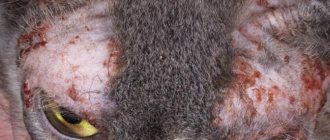Allergy to cat hair is a common problem affecting both adults and children. To effectively relieve the symptoms of inflammation, it is necessary to carry out timely diagnosis and treatment. You can also avoid health complications without giving up your beloved pet: to do this, you should have a hypoallergenic cat at home.
Allergy to cat hair
Allergy to animal fur
Allergies are caused not only by pets, but also by any other animal. The inflammatory process in the body can begin after contact with a cow, horse, mice, etc. Since most people live in cities, reactions to the hair of cats and dogs are the most common and studied.
Cat fur is often recklessly mistaken for the main culprit of allergies.
Important! The opinion that it is animal fur that acts as an allergen is erroneous. More often, the causative agent is proteins excreted in urine, feces, sweat, and pieces of the epidermis. Animal hair also contains similar substances, but in relatively small quantities. For this reason, allergies to wool in their pure form are rare.
Minimal contact with animal fur is sufficient to trigger an allergic reaction.
Most often, the proteins that cause the reaction come from the skin, from excrement, from urine to the fur. As a result of contact between a person and a pet, allergens enter the body and the inflammatory process starts.
By the way! The reaction can occur not only through direct contact with the animal, but also after staying in the room where the animal lives or previously lived. Interior items, furniture, and clothing with wool also pose a risk for allergy sufferers.
Allergies never appear immediately - it is useless to draw hasty conclusions about its causes.
It is important to consider the fact that allergies never appear on first contact. The immune system, when first encountering an irritant, produces antibodies. Externally, the process occurring inside the body is not felt. And only when encountering the allergen again does the inflammatory process begin, which manifests itself in the typical symptoms of an allergic reaction.
For this reason, it is important to interact with the pet several times before deciding whether it is safe.
Video - Animal allergies: answers to the most frequently asked questions from an allergist
Allergy to dogs
Dogs pose less of a risk to an allergy sufferer than cats. Dogs pay less attention to their toilet. The likelihood of transferring harmful substances along with saliva to the fur is significantly reduced.
Pollen, paint, dirt - everything that a dog encounters on the street, it carries in its fur.
At the same time, dogs spend a lot of time outdoors. There they are constantly in contact with plants, other animals, and various objects. As a result, animals bring home a large amount of dirt, germs, and bacteria on their fur.
Sometimes a dog acts as an innocent carrier of allergens that are not directly related to it.
All these substances can cause allergies in humans who come into contact with the animal. Moreover, the allergy will be caused precisely by the allergens carried by the dog, and not by its own fur. For example, a person may be allergic to pollen.
After contact at a party with a dog that came from the street, the person will begin an inflammatory process. An erroneous conclusion will be drawn about the presence of a reaction to animal fur, when the real allergen is pollen carried by the dog.
A dog's allergenicity depends on:
- from fur (animals with hard, non-shedding fur are less dangerous);
- on size (small breeds are more suitable for allergy sufferers than large ones).
Small, non-shedding dogs are suitable for allergy sufferers. For example, Shih Tzu
By the way! Puppies of the same breed can have different levels of allergenicity. Therefore, before purchasing a pet, you should make sure that it is compatible specifically with it.
Allergy to cats
Cats are more dangerous than dogs. They constantly take care of their hygiene - they lick their bodies from all sides. Dangerous microbes and bacteria found on the genitals, tail and paws are eventually transferred to the fur.
It is believed that cats emit more allergens than cats
The vast majority of cats have thick and fairly long hair, which becomes a carrier of allergens. Moreover, the animal’s saliva itself contains specific enzymes, which are a powerful irritant for people with weakened immune systems.
A significant negative factor is the use of a tray. Contact of paws and fur with a tray filled with bacteria guarantees the transfer of a huge number of microbes to the animal.
Cat owners should know that there will be cat hair even where there has never been a cat.
All of these factors make cats the most allergenic of possible pets. Moreover, male representatives are more dangerous than females. Cats with long fur that is prone to shedding are also more likely to be allergic. This wool remains everywhere: on carpets, on floors, on bed linen, on upholstered furniture, in the toilet, etc.
By the way! Different breeds have different degrees of risk to humans. A common misconception is that the currently popular “hairless” cats cannot cause allergies. Since the main allergen is not fur, but irritants carried by animals, the absence of hair in pets does not give their owners any guarantees.
Sphynxes are living proof that the absence of hair does not guarantee the absence of allergies in the owner
Mistakes when diagnosing allergies at home
If, after the appearance of a cat in the house, one of the household members has signs of conjunctivitis, dermatitis or rhinitis, before passing a verdict of “animal allergy”, it is necessary to carefully analyze the situation and make sure that there are no other causes for the appearance of these symptoms.
First of all, you should check whether your beloved pet has an invasive or infectious disease that can occur in both animals and humans. Thus, diseases such as toxoplasmosis, mycoplasmosis or chlamydia are often disguised as conjunctivitis and allergic rhinitis. Redness and itching of the skin can be caused by a mite infestation known as scabies, or a fungal infection known as lichen.
It is worth considering that in most cases the cat itself may not have external manifestations of the disease. Thus, an animal that has had chlamydia may not experience clinical manifestations of conjunctivitis in the form of minor discharge from the eyes, but at the same time the pet, being a carrier of the infection, can infect its owners.
The skin of many cats can be parasitized by a microscopic mite, Cheylithiella, which does not cause any problems for the animal. This parasite does not live on human skin, but once it gets on the skin, it can bite, which will lead to itching and irritation in that area.
Another common mistake when “home diagnosing” allergic reactions to a cat is incorrect identification of the allergen. So, it is likely that the cause of allergic disease is not the pets themselves. In modern times, people are increasingly faced with such phenomena as allergies to cat food, pet cosmetics, litter, toys and other accessories.
Prevalence of the problem
According to medical research, animal allergies occur in approximately 15% of the world's population. The proportion of patients who react specifically to animal fur is minimal in this 15%. As already mentioned, more often allergy sufferers react to proteins secreted by animals.
There has been an increase in the prevalence of pet allergies in recent years.
The simplest assessment criterion is the presence of woolen clothing in the wardrobe of an allergic person. If a person can wear such things without harm to his health, then with a high degree of probability he is not allergic to wool.
Causes of allergies
Many people, mistakenly believing that they are allergic to cat fur, think that if they get a short-haired animal (the Sphynx breed, for example), all the unpleasant symptoms will stop bothering them. In reality, the reaction is not provoked by the pet's fur, but by the protein contained in dead skin cells, in the pet's urine and saliva.
People suffering from allergies have reduced immunity. Therefore, their body perceives external stimuli very sensitively. It triggers a protective reaction to any allergen. If the immune system is weakened, the main symptoms of allergies occur, which are a side effect of the body's fight against irritants.
Even if a person does not suffer from a cat allergy, a pet can easily bring it on. Thus, a furry pet often brings mold, pollen and other allergens into the house from the street.
Allergy to cats: symptoms and signs
Often a person does not suspect that he has such a problem. It may take some time from the moment of contact with an animal until typical allergy symptoms appear. Diagnosis is complicated by the fact that there may be no direct contact at all. It is enough for a person to spend some time in the room where the pathogen was located, or to touch things with wool.
The duration of allergy attacks can vary greatly - from several hours to six months
In the vast majority of cases, symptoms appear within the first hours. At first, the signs of the onset of the reaction are not pronounced, but within two to three hours the process reaches its peak.
List of antihistamines
The intensity of symptoms leads to a significant deterioration in well-being and the inability to lead a normal lifestyle. Only immediate use of antihistamines helps in the shortest possible time (within about 20 minutes) to relieve the manifestations of the inflammatory process.
The severity of symptoms differs in adults and children.
In adults
Table 2. Allergy symptoms in adults
| Inflammatory process | Symptoms |
| Conjunctivitis | Itching; Swelling of the eye (a person feels as if there is a foreign body in his eye); Redness; Tearing; Difficulty in visual perception. |
| Rhinitis | Nasal congestion; Labored breathing; Itching; Sneezing; Runny nose. |
| Bronchitis | Cough; Dyspnea; Soreness; Discomfort. |
| Bronchial asthma | Dry, severe cough; Sputum separation; Suffocation; Heaviness in the chest; Wheezing; Psychological stress. |
| Skin reactions | Hives; Rash; Redness; Peeling; Itching. |
| General signs | Feeling of heat (due to vasodilation); Enlarged lymph nodes; Weakness; Irritability, anxiety; Drowsiness; Prostration. |
By the way! Of all the manifestations of allergies, bronchial asthma poses the greatest threat to life. This condition requires immediate medical attention.
In no case should you ignore the manifestation of severe allergy symptoms. In the absence of timely treatment, anaphylactic shock and Quincke's edema may occur. Such conditions are the most dangerous.
Primary symptoms of Quincke's edema
In children
The characteristic symptoms and signs of an allergic reaction in children are the same as in adults. But if in adults the symptoms manifest themselves quite intensely, then in children the reaction is even more pronounced. The process in a child’s body develops rapidly due to the imperfection of the immune system of children, which is susceptible to the negative effects of external factors.
An allergen not recognized in time can cause chronic diseases in a child later in life.
Cats pose a particular danger to babies, since children in the first years of life spend a lot of time on the floor and pick up various objects from the floor. Children often put toys and other objects with animal fur in their mouths. With direct contact between children and pets, the risk of allergies increases.
A child in close contact with an animal may be at greatest risk
You can often observe the appearance of irritation on the skin of babies at the point of contact with cat hair. At the first signs of an incipient allergic reaction, it is necessary to take action, since the inflammatory process in the child will develop at a critical speed.
Video - Children's allergies: treatment methods
Drug treatment
How to cure cat allergies using medications? The doctor will first advise you to take antihistamines that block the action of allergens. Some of them (the drugs Claritil and Benadryl) can be purchased at the pharmacy independently, while others (the drug Zyrtec) are available only with a prescription.
If you are diagnosed with a cat allergy, what does traditional medicine advise to do in this case? Decongestants, which include the drugs Allgra-D and Sudafed, have proven themselves to be effective in solving this problem. Their task is to reduce swelling and prevent mucosal stagnation.
Other medications can also help relieve allergy symptoms easily. For example, Nasonex and Flonaz sprays, traditionally used to eliminate allergic reactions, are especially effective.
One of the options for getting rid of allergies is a course of injections. But it is worth noting that such treatment, which is also not always effective, can last more than one year. This method of combating allergies is unsafe, and therefore it is prohibited for children under 5 years of age.
Diagnostics
Timely diagnosis is the most important aspect of solving the problem, since it allows us to conclude that there is a reaction to a specific allergen. It is on the basis of the diagnostic results obtained that pet owners can decide on the need to exclude contact with the animal.
The most common allergy test is skin testing, but it may not be suitable for some people.
At the first suspicion, you should consult an allergist, who, after conducting the necessary research, will conclude that you have an allergy. If related problems caused by a reaction to an allergen are identified, it may be necessary to contact other specialists:
- for skin manifestations - see a dermatologist;
- for bronchial asthma - see a pulmonologist;
- if kidney function is impaired, see a nephrologist;
In critical conditions (Quincke's edema, anaphylactic shock), an emergency call may be required.
Failure to provide first aid can cost an allergic person his life
When making a diagnosis, the allergist conducts a survey, examines the patient, and prescribes laboratory tests.
The most informative analyses:
- general blood analysis;
- general urine analysis;
- blood chemistry;
- immunogram;
- identification of lymphocytes sensitized to cat tissues;
- prick tests.
Interesting Facts
It has been proven that cats, compared to cats, spread significantly fewer allergens. Also, the younger the pet, the less irritants it produces. Spayed and neutered four-legged friends are less allergenic than full-fledged cats.
Studies have found that, regardless of breed and gender, allergic reactions to these pets of a dark pattern or color occur in people much more often than to light-colored cats. The allergenic properties of saliva, urine and skin of animals do not depend on the length of the coat and the breed.
Knowing how to cure allergies to cats and following the given recommendations for keeping a pet, you can get rid of unpleasant allergic manifestations without parting with your beloved four-legged friend.
Protect your eyes with BLUBOO S1 - the smartphone is equipped with tempered glass against blue light If you consider yourself to be one of the people who simply cannot sleep until they look at all the pages on social networks, or for whom a smartphone is the first thing.
Why do you need a tiny pocket on jeans? Everyone knows that there is a tiny pocket on jeans, but few have thought about why it might be needed. Interestingly, it was originally a place for storage.
15 Cancer Symptoms Women Most Often Ignore Many signs of cancer are similar to symptoms of other diseases or conditions, which is why they are often ignored. Pay attention to your body. If you notice.
Contrary to all stereotypes: a girl with a rare genetic disorder conquers the fashion world. This girl's name is Melanie Gaydos, and she burst into the fashion world quickly, shocking, inspiring and destroying stupid stereotypes.
How to look younger: the best haircuts for those over 30, 40, 50, 60 Girls in their 20s don’t worry about the shape and length of their hair. It seems that youth is created for experiments with appearance and daring curls. However, already last.
What is it like to be a virgin at 30? I wonder what it’s like for women who didn’t have sex until almost middle age.
Sources: , ,
Treatment
Traditional therapeutic measures
- taking antihistamines that block the development of the reaction by suppressing the activity of pathogenic microorganisms (Cetrin, Suprastinex, Zodak, Dezal, Neoclaritin, Allegra, Telfast, etc.);
- the use of eye drops that relieve swelling of the mucous membrane (Allergodil, Cromohexal, Opatanol, Lecrolin, etc.);
- the use of nasal drops, sprays (“Vibrocil”, “Nosephrine”, “Nasonex”, “Cromohexal”, etc.);
- the use of drugs that relieve bronospasm (Berotek, Berodual, Salbutamol, Seretide).
- the use of ointments that eliminate skin manifestations (Advantan, Elokom, Fenistil2);
- taking sorbents that remove the allergen (Polysorb, Smecta, activated carbon, Sorbex, Sorbolong, etc.).
Drug treatment should be carried out in courses. The duration of taking medications and their dosage must be determined by a doctor. Regular preventive use of antihistamines can significantly make the patient’s life easier.
Remember that prevention should be periodic and should not be neglected under any circumstances.
Not all of the drugs listed are suitable for children, so when prescribing a course of treatment for young patients, doctors are guided by age restrictions and choose the most gentle method of treatment. Children under 3 years of age are recommended to be given antihistamines in the form of syrups - they will not cause a negative reaction in children.
Emergency measures
If the situation requires taking emergency measures, you must:
- Avoid contact with the allergen.
- Remove the allergen from the body by taking a sorbent.
- Eliminate symptoms using targeted agents (eye drops, nasal sprays, etc.).
- Take an antihistamine.
- Call an ambulance (if the condition does not improve).
If a child develops symptoms, an ambulance should be called immediately
Autolymphocytotherapy
A modern method of solving the problem is autolymphocytotherapy. The essence of the method is to use the patient’s own immune cells to restore the protective functions of his immune system. As a result, the level of susceptibility to potential allergens is significantly reduced.
Autolymphocytotherapy has its contraindications, which need to be discussed with a specialist.
During therapy, the patient undergoes several procedures on an outpatient basis at intervals of several days. During each procedure, he is given a vaccine containing a certain dose of the allergen. Each time the dose is increased. Thus, the immune system develops resistance to the irritant and gradually stops responding to it.
The number of necessary procedures is 6-8 with an interval of 2-6 days. As a result, a person ceases to feel any symptoms of the incipient inflammatory process upon contact with pets.
The therapeutic effect of autolymphocytotherapy
Allergy treatment: highlights
Getting rid of allergies forever is an almost impossible task, and with a high degree of probability we can say that from time to time this illness will remind itself of itself. But at the same time, it is quite possible to significantly alleviate a person’s condition and prevent the occurrence of new rounds of the disease with even more acute symptoms.
So, if you are allergic to a cat, what should you do? First of all, it is necessary to completely limit any contact with your pet. It is also important to control your emotional sphere and try to prevent the influence of various stress factors on the body, which arise mainly due to separation from your beloved animal.
The main question that most allergy sufferers are trying to find an answer to is: “Where should I put my expensive pet, without which it seems simply impossible to live?” Parting is certainly very difficult to bear. But if a person suffers from an advanced allergy to cats, then this is extremely necessary. But it is better at this time to think about where the pet will be comfortable. For example, you can give your cat to relatives or close friends to ensure that the animal is taken care of.
Prevention
Before purchasing an animal, it is advisable to take allergy tests in advance to avoid further problems.
Compliance with preventive recommendations will not only reduce the risk of allergies, but also reduce the severity of the inflammatory process in a person susceptible to the reaction. You need to do the following:
- see an allergist;
- always carry prescribed medications with you;
- undergo treatment courses;
- constantly increase immunity (proper nutrition, hardening, sports, proper sleep, vitamins);
- monitor your well-being;
- get hypoallergenic cat breeds;
- bathe the animal frequently;
- do not allow the animal on the bed, table, or furniture;
- carry out regular wet cleaning;
- wash, clean animal accessories (mat, tray, dishes);
- avoid too close contact with the animal;
- wash hands after contact.










